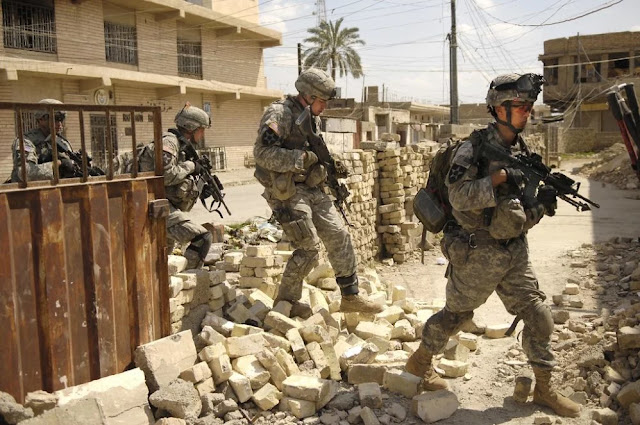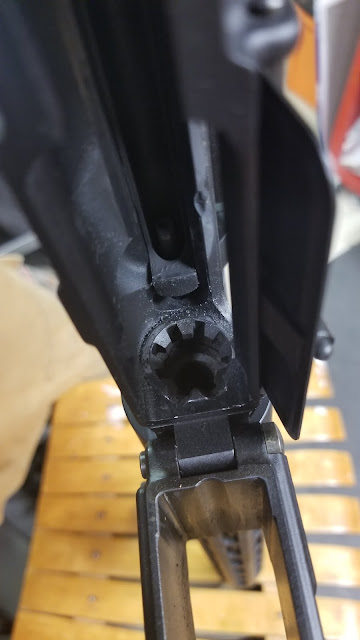The "Assault Rifle" Concept
 |
| Source |
Introduction:
The assault rifle as we are familiar with it today has been a staple of warfare since the end of the Second World War. Assault rifles are typically defined as being select-fire rifles that fire an intermediate cartridge, such as 5.56 or 7.62x39mm. There are also "battle rifles" that are in slightly larger calibers such as 7.62 NATO. However, because Assault Rifle is a more well-defined term, and 7.62 NATO was designed as an 'intermediate' cartridge, I'm going to include rifles such as the FAL and SCAR-H under the moniker of "Assault Rifles". I'm going to try to give a brief overview of the history behind the assault rifle concept, and how the idea spread to be the definition of a modern service rifle.
Details:
In order to understand the necessity of the assault rifle, you need to go back to WWI and WWII. WWI was a war of outdated tactics combined with modern warfighting technology. For US forces, there was a heavy emphasis on marksmanship, so a bolt action rifle with good sights was seen as the right tool for the job. By the end of the war, countries on all sides discovered that small caliber automatic or semi automatic weapons were much more effective in a trench raid than bolt action rifles with full-power cartridges.
 |
| A French Trench Raider that decided that a revolver and knife would do his job better than a bolt-action rifle |
Germany took this lesson from WWI and began development on their intermediate 8mm Kurtz cartridge during the inter-war period. This lead to a series of developments that would culminate in the Sturmgewehr-44 or STG-44. Other countries were not as quick to adopt the idea, and instead kept their full-power rifles throughout much of the war. As the war went on, the Allies noticed that most infantry engagements, more often than not, happened within 400m, well under the maximum range of the full power rifle cartridges they were using at the time. Many guys on the ground began favoring lower powered weapons such as the American M1 Carbine or the Russian PPSh-41 over the standard-issue rifles.
 |
| Soviet soldiers in Berlin, not a Mosin Nagant in sight. |
After the war, the Allies took a look at the STG-44 and how it was used. It was a novel idea for the time, giving every infantryman the power of an automatic rifle, with a low recoil cartridge that still had enough power to reach out to around 400m. The Soviets and the West took the idea and ran with it, with two different results. The Russians developed the SKS, with the AK-47 designed to be its counterpart. Because of the large-scale SMG use by the Soviets in the war, the AK was developed as an SMG to be used alongside a rifle (the SKS) and an LMG (the RPD). The West on the other hand, instead of essentially making a more powerful SMG, created less powerful rifles in a new 7.62 NATO cartridge.
The Western rifles developed after WWII were what we now call Battle Rifles. These are the FAL, G3, AR-10, and M14. These are not thought of as full-on assault rifles due to the fact that they fire a cartridge that has pretty high recoil. There was a big disadvantage to this that America found out first-hand in Vietnam.
Now, the M14 was not the best Cold War Era rifle that was used by the West, but the US found itself at a serious disadvantage going into close-quarters jungles of Vietnam armed with an 11 lb 7.62 NATO rifle. The military had to look for something better, so they turned to the M16. The M16 was a true assault rifle as we define them today. It was a lightweight, select-fire rifle, chambered in a truly intermediate cartridge, 5.56 NATO.
Conclusion
With the introduction for 5.56 and 5.45, the standard was set for service rifles throughout the world. Most service rifles are 5.56 or 7.62 NATO, 5.45x39, or 7.62x39, with China being the exception. Development of weapons designed for the average rifleman are all derivatives of the assault rifle concept, and I don't see any reason why this would change any time soon. As weapons technology progresses into the future, I suspect that the only thing that cartridge development moves forward into things like caseless ammunition or telescoping cartridges. Aside from that, I expect the assault rifle to remain generally the same concept for years to come.

Comments
Post a Comment